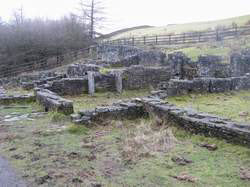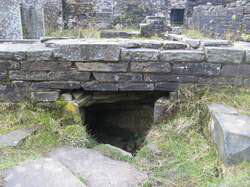Abandoned Communities ..... Haslingden Grane
Haslingden Grane is a valley west of the town of Haslingden in Lancashire. Around the middle of the nineteenth century it contained a thriving community. About 1500 people lived in the valley, some 600 of them in a village close to the main road to Blackburn, and the rest in several dozen farms and hamlets scattered around the valley.
By the 1920s almost everyone had left Haslingden Grane. There had been a gradual decline in the opportunities for employment within the valley, and in addition the creation of a string of three reservoirs accelerated the process of depopulation. The village and most of the farms lay above the reservoirs, but as the Bury and District Water Board had bought most of the land in the lower parts of the valley residents were obliged to leave when their tenancies came to an end and farmers had to forfeit much of their best land.
A vivid picture of life in the Grane from the sixteenth century to the nineteenth century has been provided in a book by Alan Crosby, The History of Haslingden Grane, published by Lancashire County Council in 1991. Throughout that period there were close links between farming and the textile industry. Alan Crosby's book reproduces an inventory listing the possessions of William Hartley in 1625. Hartley owned two oxen, five kine, two young beasts, two horses, and an unspecified number of sheep, but also listed are wool, woollen cloth, spinning wheels, combs, and cards.
There was a limited amount of arable farming, mainly oats, but the valley landscape was generally more suited to keeping livestock, especially sheep. Each farm would have had an area for pasture and perhaps a hay meadow close to the Ogden brook, and in addition they would have been entitled to use the common land on the moors above the valley. The moorland was used not just for grazing, but also for cutting peat to use as fuel and gathering rushes that could provide dim lighting. In addition heather, gorse, and reeds were collected for the construction of thatched roofs or to cover the floor in cattle sheds.
Some of the farmhouses developed into hamlets as cottages and other buildings grew around them. Farmers and their families enhanced their income by spinning wool and weaving it into cloth. Other people would live nearby and be employed as weavers.
The ruins of several of the small settlements in the Grane can still be seen today. Hartley House, for example, lay about three hundred yards west of the village. A field and rate survey of 1798 indicates that it comprised two farmhouses and four cottages. Three of the cottages were occupied by weavers named Charles Scott, Henry Haworth, and James Barnes. The farm had about 40 acres of land, including 30 acres of pasture, six of meadow, three of woodland, and one and a half acres of arable land. By 1827 there were four farms at Hartley House and six other dwellings. Loom shops had been added to two of the farmhouses in order to expand the space for weaving.
Census information reveals the gradual decline of the Hartley House settlement after 1827. Some of the residents of the cottages in 1841 were listed as weavers, but no weavers are recorded in later censuses. By 1881 only 5 dwellings remained. The rest had been turned into farm buildings or demolished. In that year three of the farmhouses were still occupied, but in two of them the farmer had a second occupation, one as a quarryman the other a clogger.
By the 1920s almost everyone had left Haslingden Grane. There had been a gradual decline in the opportunities for employment within the valley, and in addition the creation of a string of three reservoirs accelerated the process of depopulation. The village and most of the farms lay above the reservoirs, but as the Bury and District Water Board had bought most of the land in the lower parts of the valley residents were obliged to leave when their tenancies came to an end and farmers had to forfeit much of their best land.
A vivid picture of life in the Grane from the sixteenth century to the nineteenth century has been provided in a book by Alan Crosby, The History of Haslingden Grane, published by Lancashire County Council in 1991. Throughout that period there were close links between farming and the textile industry. Alan Crosby's book reproduces an inventory listing the possessions of William Hartley in 1625. Hartley owned two oxen, five kine, two young beasts, two horses, and an unspecified number of sheep, but also listed are wool, woollen cloth, spinning wheels, combs, and cards.
There was a limited amount of arable farming, mainly oats, but the valley landscape was generally more suited to keeping livestock, especially sheep. Each farm would have had an area for pasture and perhaps a hay meadow close to the Ogden brook, and in addition they would have been entitled to use the common land on the moors above the valley. The moorland was used not just for grazing, but also for cutting peat to use as fuel and gathering rushes that could provide dim lighting. In addition heather, gorse, and reeds were collected for the construction of thatched roofs or to cover the floor in cattle sheds.
Some of the farmhouses developed into hamlets as cottages and other buildings grew around them. Farmers and their families enhanced their income by spinning wool and weaving it into cloth. Other people would live nearby and be employed as weavers.
The ruins of several of the small settlements in the Grane can still be seen today. Hartley House, for example, lay about three hundred yards west of the village. A field and rate survey of 1798 indicates that it comprised two farmhouses and four cottages. Three of the cottages were occupied by weavers named Charles Scott, Henry Haworth, and James Barnes. The farm had about 40 acres of land, including 30 acres of pasture, six of meadow, three of woodland, and one and a half acres of arable land. By 1827 there were four farms at Hartley House and six other dwellings. Loom shops had been added to two of the farmhouses in order to expand the space for weaving.
Census information reveals the gradual decline of the Hartley House settlement after 1827. Some of the residents of the cottages in 1841 were listed as weavers, but no weavers are recorded in later censuses. By 1881 only 5 dwellings remained. The rest had been turned into farm buildings or demolished. In that year three of the farmhouses were still occupied, but in two of them the farmer had a second occupation, one as a quarryman the other a clogger.
One
Plan of Haslingden Grane village and some of the farms and hamlets in the valley
Plan of the hamlet at Hartley House
These two plans come from Alan Crosby’s book, The History of Haslingden Grane. Apologies for the reflections.
The remains of Hartley House
The well at Hartley House
The dairy at Hartley House, or possibly a cold storage area.




